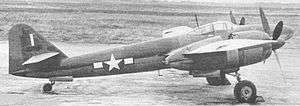Mitsubishi Ki-83
| Ki-83 | |
|---|---|
 | |
| An Ki-83 in American markings after the war. | |
| Role | Long-Range Heavy Fighter |
| Manufacturer | Mitsubishi |
| Designer | Tomio Kubo |
| First flight | 18 November 1944 |
| Status | Prototype |
| Number built | 4 |
|
| |
The Mitsubishi Ki-83 (キ83 (航空機)) was a Japanese experimental long-range heavy fighter designed near the end of World War II. It did not reach production status.
Design and development
The Mitsubishi Ki-83 was designed as a long-range heavy fighter. It was designed and built by a team led by Tomio Kubo, the designer of the highly successful Mitsubishi Ki-46 "Dinah". The design was a response to a 1943 specification for a new heavy fighter with great range. The first of four prototypes flew on 18 November 1944.[1] The machines displayed remarkable maneuverability for aircraft of their size, being able to execute a 671 m (2,200 ft) diameter loop in just 31 seconds at a speed of over 644 km/h (400 mph).[2] The Ki-83 carried a powerful armament of two 30 mm (1.18 in) and two 20 mm cannon in its nose.[3]
Despite the bomb-ravaged Japanese manufacturing sector, plans for the Ki-83 to enter production within were underway when Japan surrendered on 15 August 1945.
Both the existence and performance of the Ki-83 were little known during the war, even in Japan. It was completely unknown in Allied military aviation circles – as demonstrated by the fact that the Ki-83 had not been given a reporting name. Most early photographs of the type were taken during the post-war occupation of Japan, when the four prototypes were seized by the United States Army Air Forces and re-painted with USAAF insignia. When they were evaluated by US aeronautical engineers and other experts, a Ki-83 using high-octane fuel reached a speed of 762 km/h (473 mph), at an altitude of 7,000 metres (23,000 ft). [1][2][4][5]

Versions
- Ki-83 experimental long-range heavy fighter, four prototypes built.
- Ki-95 projected reconnaissance version, none built.[6]
- Ki-103 projected development, none built.[6]
Specifications
Data from Japanese Aircraft of the Pacific War[7]
General characteristics
- Crew: 2
- Length: 12.50 m (41 ft 0⅛)
- Wingspan: 15.50 m (50 ft 10¼ in)
- Height: 4.60 m (15 ft 1 in)
- Wing area: 33.5 m² (361 ft²)
- Empty weight: 5,980 kg (13,184 lb)
- Loaded weight: 8,795 kg (19,390 lb)
- Max. takeoff weight: 9,430 kg (20,790 lb)
- Powerplant: 2 × Mitsubishi Ha-211 Ru (Ha-43) 18-cylinder air-cooled radial engines, 1,544 kW (2,070 hp) at 1,000 m (3,284 ft) each
Performance
- Maximum speed: 705 km/h (381 kn, 438 mph at 32,180 ft) at 9,000 m (29,500 ft)
- Cruise speed: 450 km/h (243 kn, 280 mph)
- Range: 1,953 km (1,054 nmi, 1,213 mi)
- Service ceiling: 12,600 m (41,500 ft)
- Wing loading: 263 kg/m² (53.7 lb/ft²)
- Power/mass: 0.35 kW/kg (0.21 hp/lb)
- Climb to 10,000 m (32,800 ft): 10 min
Armament
- Guns: 2× 30 mm (1.18 in) and 2× 20 mm cannon mounted in the fuselage nose
See also
- Arado Ar 440
- de Havilland Hornet
- Dornier Do 335
- Focke-Wulf Ta 154
- Grumman F7F Tigercat
- Junkers Ju 388
- Kawasaki Ki-96
- Lockheed XP-58 Chain Lightning
- McDonnell XP-67
- Savoia-Marchetti SM.92
- Messerschmitt Me 265
- Messerschmitt Me 410
- Messerschmitt Me 609
- Nakajima J5N
- North American F-82 Twin Mustang
- Northrop P-61 Black Widow
- Rikugun Ki-93
References
- Notes
- 1 2 Francillon 1979, p. 192.
- 1 2 Green 1961, p. 58.
- ↑ Pearce, William. "Mitsubishi Ki-83 Heavy Fighter". oldmachinepress.com. Retrieved 2 June 2016.
- ↑ Green and Swanborough 1976, pp. 53, 56.
- ↑ FAOW 1976, p. 50.
- 1 2 Francillon 1979, p. 193.
- ↑ Francillon 1979, p. 194.
- Bibliography
- Francillon, Ph.D., René J. Japanese Aircraft of the Pacific War. London, Putnam & Company Ltd., 1970. second edition 1979. ISBN 0-370-30251-6.
- Green, William. Warplanes of the Second World War, Volume Three: Fighters. London: Macdonald & Co. (Publishers) Ltd., 1961 (seventh impression 1973). ISBN 0-356-01447-9.
- Green, William and Gordon Swanborough. WW2 Aircraft Fact Files: Japanese Army Fighters, Part 1. London: Macdonald & Jane's Publishers Ltd., 1976. ISBN 0-356-08224-5.
- Unknown Author(s). Famous Aircraft of the World, first series, no.76: Japanese Army Experimental Fighters (1). Tokyo, Japan: Bunrin-Do Co. Ltd., August 1976.
External links
| Wikimedia Commons has media related to Mitsubishi Ki-83. |